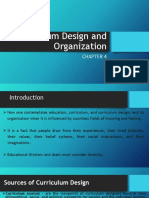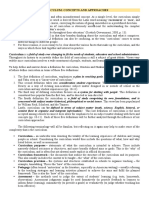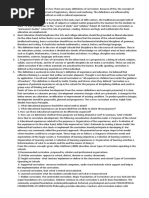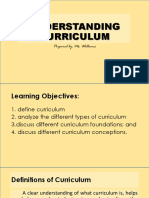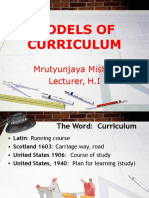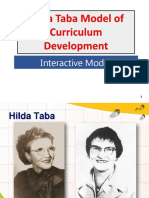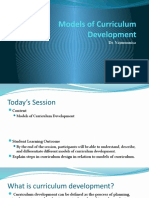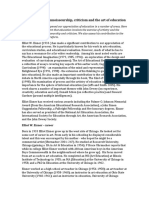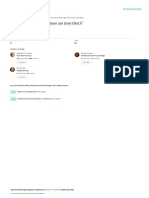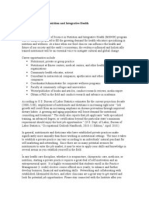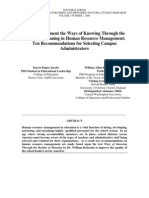86%(7)86% found this document useful (7 votes)
4K viewsEisner's Model
Elliot Eisner was a professor of art and education at Stanford University. He was concerned that the American education system placed art on a lesser level of importance and was unbalanced. Eisner believed that education itself is an artistic activity that allows people to think more creatively. His artistic approach to curriculum planning comprised seven components: goals and priorities, content sources, types of learning opportunities, organization of opportunities, organization of content areas, modes of presentation and response, and types of evaluation procedures.
Uploaded by
Joan Patrice Mondarez MangalileCopyright
© © All Rights Reserved
Available Formats
Download as PPTX, PDF, TXT or read online on Scribd
86%(7)86% found this document useful (7 votes)
4K viewsEisner's Model
Elliot Eisner was a professor of art and education at Stanford University. He was concerned that the American education system placed art on a lesser level of importance and was unbalanced. Eisner believed that education itself is an artistic activity that allows people to think more creatively. His artistic approach to curriculum planning comprised seven components: goals and priorities, content sources, types of learning opportunities, organization of opportunities, organization of content areas, modes of presentation and response, and types of evaluation procedures.
Uploaded by
Joan Patrice Mondarez MangalileCopyright
© © All Rights Reserved
Available Formats
Download as PPTX, PDF, TXT or read online on Scribd
You are on page 1/ 13
Eisner’s Model
(Elliot Eisner’s Artistic Approach)
Elliot W. Eisner
•He is a professor of Art and
Education at the Stanford
University School of Education.
•His research interests include
arts education, curriculum
reform, qualitative research
methods, among others.
•Eisner become worried that the
current model of education in
America was unbalanced and
placed art on a lesser level of
importance.
Another aspect of Eisner’s view of education, was the
idea that education itself is an artistic activity.
From the perspective of
education as art, Eisner
argued that this would
allow us to move beyond
the technical know how
and instructive reliance,
and instead open our
minds to more creative
ways of knowing and
being.
Eisner’s Artistic Approach
This artistic approach to curriculum
planning by Elliot W. Eisner was developed
with a combination of his interest in art
education and curriculum. It comprises seven
components, which are as follows:
1. The goals and their priorities. He stressed
out that the term “objectives” is the most
specific statement compared to “aims” and
“goals” and it is not always possible to have
very specific objectives.
2. The content of the curriculum. Eisner have
similar belief with that of Tyler, that
curriculum developers should consider the
three basic sources from which content can
be drawn: individual, society and subject
matter.
3. The types of learning opportunities. He also
considered that different learning
opportunities should be given to the students
wherein the curriculum planners and teachers
play a very important role.
4. The organization of learning opportunities.
Curriculum planners must organize learning
opportunities that will be given to students
with teachers, input the planning process.
5. The organization of content areas. Similar
with that of Taba, Eisner also think that the
teachers are responsible for organizing the
activities and the content to be learned by the
students.
6. The mode of presentation and mode of
response. He pointed out that diverse modes
of communication should be used in the
classroom in presenting the curriculum to
provide a wide variety of learning
opportunities.
7. The types of evaluation procedure. This last
component, according to Eisner, evaluation
encompasses the entire process of curriculum
planning and development.
References:
• https://www.giarts.org/article/elliot-w-eisner-
role-arts-educating-whole-child
• https://
www.scribd.com/document/190653297/Elliot
-Eisner-Presentation-pdf
You might also like
- Report - Curriculum Design and Organization100% (6)Report - Curriculum Design and Organization43 pages
- Ralph Tyler Model of Curriculum Development100% (8)Ralph Tyler Model of Curriculum Development2 pages
- SUBMITTED TO: Prof. Ma. Wenna Fernandez SUBMITTED BY: Sofelyn Yee Alvarez - CTP John Godfrey C. Cose Peter F. Oliva100% (4)SUBMITTED TO: Prof. Ma. Wenna Fernandez SUBMITTED BY: Sofelyn Yee Alvarez - CTP John Godfrey C. Cose Peter F. Oliva2 pages
- John Franklin Bobbitt The Scientific Method of Curriculum Making100% (3)John Franklin Bobbitt The Scientific Method of Curriculum Making14 pages
- Curriculum From Different Points of View There Are Many Definitions of Curriculum100% (3)Curriculum From Different Points of View There Are Many Definitions of Curriculum5 pages
- Psychological Foundations of Curriculum-Dr. D91% (47)Psychological Foundations of Curriculum-Dr. D56 pages
- Module 8 - CYCLICAL AND DYNAMIC DEVELOPMENT MODELS100% (2)Module 8 - CYCLICAL AND DYNAMIC DEVELOPMENT MODELS7 pages
- Chapter 4 - Curriculum Development Models - Elaiza Fruelda - BEED III100% (3)Chapter 4 - Curriculum Development Models - Elaiza Fruelda - BEED III34 pages
- Understanding Curriculum: Prepared By: Ms. Williams100% (2)Understanding Curriculum: Prepared By: Ms. Williams24 pages
- Chapter 4: Curriculum Development: The Teacher and The School Curriculum A Guide To Curriculum DevelopmentNo ratings yetChapter 4: Curriculum Development: The Teacher and The School Curriculum A Guide To Curriculum Development21 pages
- MODULE 2 LESSON 3 Curriculum Development Processes and ModelsNo ratings yetMODULE 2 LESSON 3 Curriculum Development Processes and Models5 pages
- Assignment No. 1: Q.1 Discuss The Concept and Scope of Curriculum50% (2)Assignment No. 1: Q.1 Discuss The Concept and Scope of Curriculum19 pages
- The Teacher and The Curriculum Module 1.2.docx-1100% (2)The Teacher and The Curriculum Module 1.2.docx-14 pages
- 3 Group 3 - Curriculum-Development-Models-Group-3-Module-4No ratings yet3 Group 3 - Curriculum-Development-Models-Group-3-Module-468 pages
- MODELS OF CURRICULUM EVALUATION - TYler, Cronbach, Stakes100% (2)MODELS OF CURRICULUM EVALUATION - TYler, Cronbach, Stakes21 pages
- Curriculum Designs and Oliva's 10 AxiomsNo ratings yetCurriculum Designs and Oliva's 10 Axioms8 pages
- Module 1 The Teacher and The School Curriculum0% (1)Module 1 The Teacher and The School Curriculum8 pages
- Elliot W. Eisner, Connoisseurship, Criticism and The Art of EducationNo ratings yetElliot W. Eisner, Connoisseurship, Criticism and The Art of Education21 pages
- Tools and Materials Needed For Manicure and PedicureNo ratings yetTools and Materials Needed For Manicure and Pedicure43 pages
- Teacher's Tasks in Collaborative LearningNo ratings yetTeacher's Tasks in Collaborative Learning12 pages
- Tools and Materials in Pedicure, ManicureNo ratings yetTools and Materials in Pedicure, Manicure4 pages
- Philippine Occupational Health and Safety StandardsNo ratings yetPhilippine Occupational Health and Safety Standards14 pages
- Subtraction of Whole Numbers With Continuous or Non-Continuous Zeros With RegroupingNo ratings yetSubtraction of Whole Numbers With Continuous or Non-Continuous Zeros With Regrouping7 pages
- Digital Divide Effects on Education Development in AfricaNo ratings yetDigital Divide Effects on Education Development in Africa21 pages
- Laurel Springs School Profile 2020 2021 FinalNo ratings yetLaurel Springs School Profile 2020 2021 Final3 pages
- Aet 562 wk2 Discussion Board Collaborating With Social MediaNo ratings yetAet 562 wk2 Discussion Board Collaborating With Social Media2 pages
- SOP (Public Health and health promotion)No ratings yetSOP (Public Health and health promotion)2 pages
- Study Review of Role of Sarva Shiksha Abhiyan SSA in The Development of Elementary Education JBM 2018No ratings yetStudy Review of Role of Sarva Shiksha Abhiyan SSA in The Development of Elementary Education JBM 20185 pages
- Tai Sophia Institute Master of Science in Nutrition and Integrative HealthNo ratings yetTai Sophia Institute Master of Science in Nutrition and Integrative Health4 pages
- 6 Monday 1 Mathematic 30 Minutes Numbers and Operation 1.0 Whole Numbers Up To 100No ratings yet6 Monday 1 Mathematic 30 Minutes Numbers and Operation 1.0 Whole Numbers Up To 1003 pages
- Daily Lesson Plan Class Date Time Venue Attendance: PedagogyNo ratings yetDaily Lesson Plan Class Date Time Venue Attendance: Pedagogy4 pages
